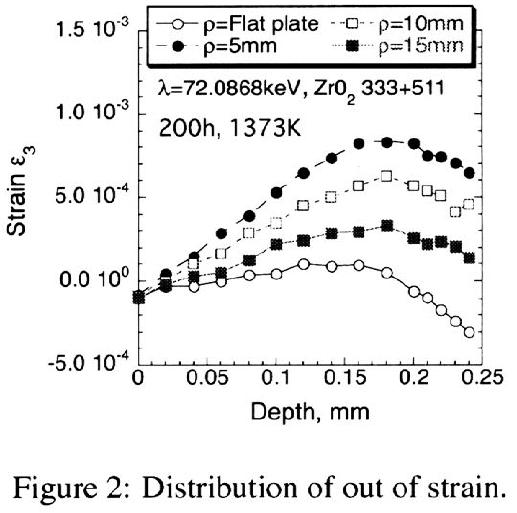Residual stress measurement
問い合わせ番号
SOL-0000000931
ビームライン
BL02B1(単結晶構造解析)
学術利用キーワード
| A. 試料 | 無機材料 |
|---|---|
| B. 試料詳細 | 金属・合金, 結晶性固体, 結晶 |
| C. 手法 | X線回折, X線弾性散乱 |
| D. 手法の詳細 | 広角散乱 |
| E. 付加的測定条件 | 偏光(直線), マイクロビーム(>10μm), 室温 |
| F. エネルギー領域 | X線(>40 keV) |
| G. 目的・欲しい情報 | 欠陥、転位、歪み |
産業利用キーワード
| 階層1 | 機械, 金属, 建設, 工業材料 |
|---|---|
| 階層2 | 燃料電池, 構造材(鉄、非鉄) |
| 階層3 | |
| 階層4 | 残留応力 |
| 階層5 | 回折 |
分類
A80.20 金属・構造材料, A80.30 無機材料, M10.80 歪み解析
利用事例本文
X-ray residual stress measurement is a efficient technique to study a strain in a crystal lattice. Using this technique, one can measure a residual stress and strain of materials. This technique has the advantage of not only nondestructive inspection in use condition but also near surface sensitivity. The figure shows the out-of-plane strain of the thermal barrier coating which was made by a plasma spraying method. These data reveal the fact that the out-of-plane strain in the thermal barrier coating follows curvature of substrates.
画像ファイルの出典
所内報
誌名
Experiment Reports 2004A
ページ
19
測定手法
X-ray residual stress measurement is a efficient technique to study a strain in a crystal lattice. The technique is applicable to materials in use condition and provides knowledge about a residual stress and strain.
画像ファイルの出典
図なし
測定準備に必要なおおよその時間
8 時間
測定装置
| 装置名 | 目的 | 性能 |
|---|---|---|
| 4-circle diffractometer | diffraction intensity measurement |
参考文献
| 文献名 |
|---|
| K. Suzuki and K. Tanaka, Texture and Microstructures 35, 207 (2003). |
関連する手法
neutron diffraction, coating method, ultrasonic method
アンケート
SPring-8だからできた測定。他の施設では不可能もしくは難しい
本ビームラインの主力装置を使っている
測定の難易度
初心者でもOK
データ解析の難易度
初心者でもOK
図に示した全てのデータを取るのにかかったシフト数
4~9シフト


